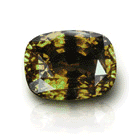Opal is one of the birthstones for the month of October, the other being Pink Tourmaline. Opal is most often finished with a rounded top, known as cabochon. Pink tourmaline is almost always faceted, but is also cut 'en cabochon' as well.
The name Opal was probably derived from Sanskrit “upala“, meaning ”valuable stone“. This was probably the root for the Greek term “opallios”, which translates as “color change”. In the days of Roman antiquity there existed a so-called “opalus”, or a “stone from several elements”. Opal’s color play emanates a very special attraction and fascination. But what causes this phenomenon? This question was impossible to answer for a very long time. Only when in the 1960s a team of Australian scientists analyzed Opals with an electron microscope, it was discovered that small spheres from silica gel caused interference and refraction manifestations, which are responsible for the fantastic play of colors. The spheres, which are arranged in more or less compact structures, succeed in dissecting the light on its passage through the gemstone and turning it into all the colors of the rainbow, always new and always different.
Always new...those words remind me of Jesus for two reasons.
When we accept Jesus Christ as our Savior, we become a new creation, a new work. 2 Corinthians 5:17 states, "Therefore if any man be in Christ, he is a new creature: old things are passed away; behold, all things are become new." (KJV)
And Revelation 21:5, "And he that sat upon the throne said, Behold, I make all things new. And he said unto me, Write: for these words are true and faithful."(KJV)

Like so many colors of light that come out of Opal, Jesus is the Light that shines healing on so many troubles, makes a difference, and makes all things new.
NEXT POST: The Gems of Exodus and Revelation - Agate & Chalcedony
*The Gems of Exodus and Revelation are presented in twelve monthly installments and will explore the similarities between the stones in the ephod (breastplate) of Aaron and the stones of the New Jerusalem, and their relation to Jesus.










